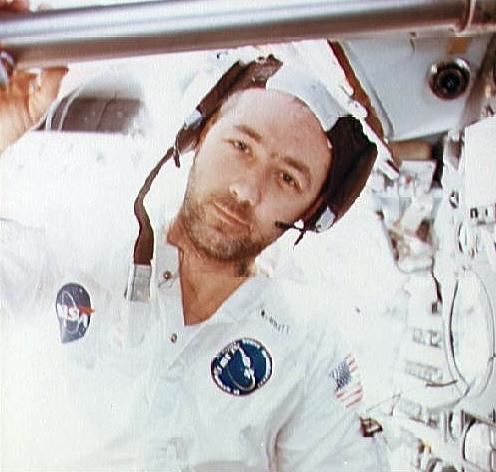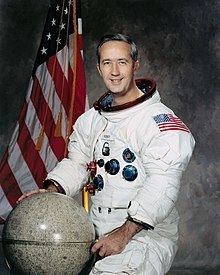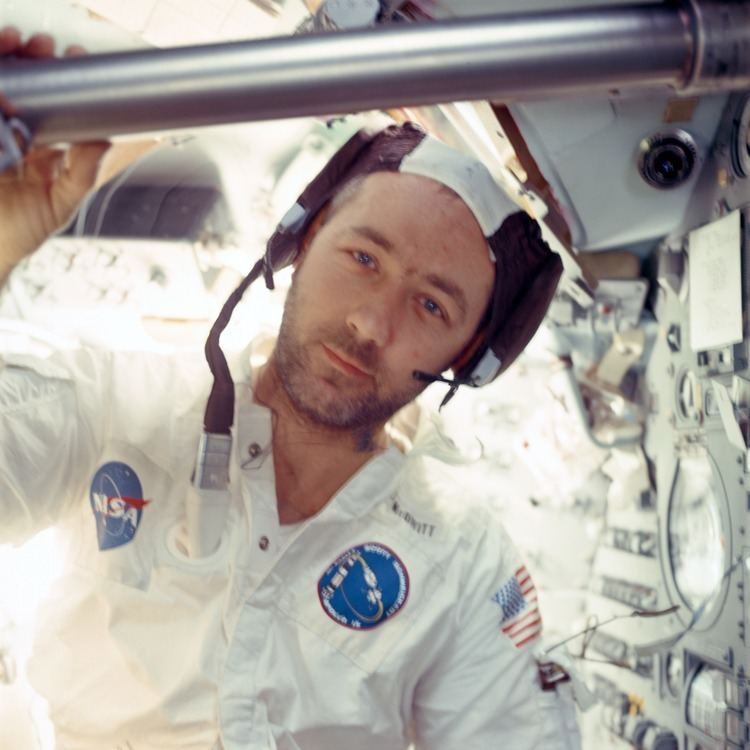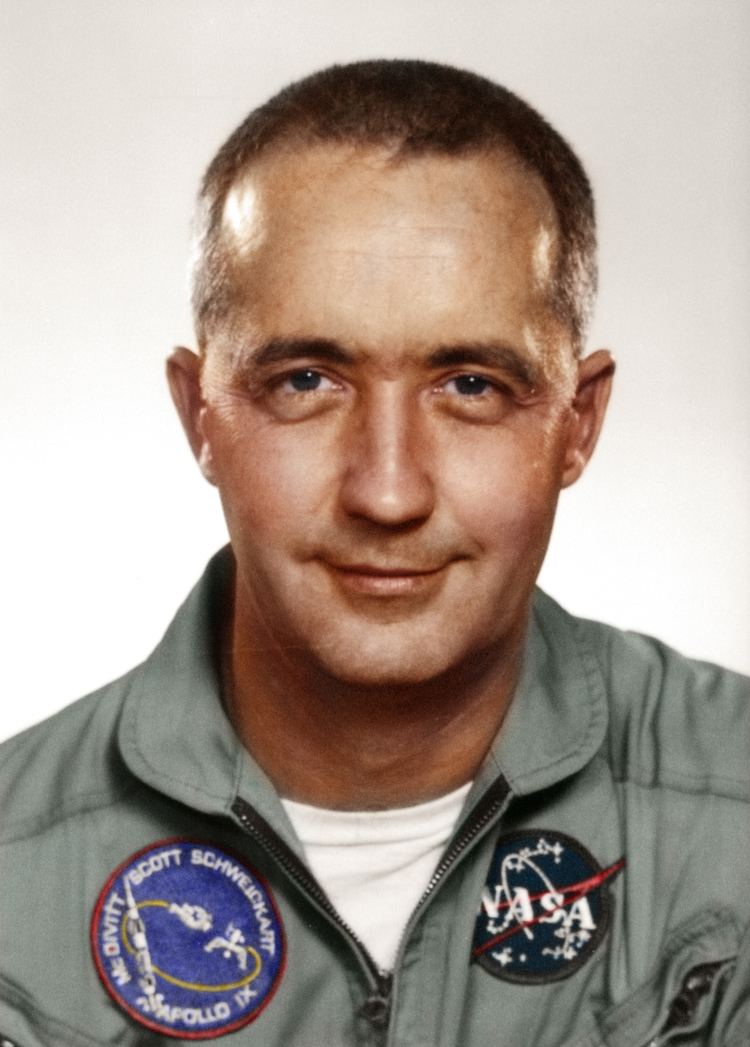Nationality American Name James McDivitt Time in space 14d 02h 56m | Other names James Alton McDivitt Status Retired Role Astronaut | |
 | ||
Previous occupation Test pilot, business executive Similar People | ||
Astronaut james mcdivitt ufo sighting
James Alton "Jim" McDivitt (born June 10, 1929), (Brig Gen, USAF, Ret.), is an American former test pilot, United States Air Force pilot, aeronautical engineer, and NASA astronaut who flew in the Gemini and Apollo programs. He commanded the Gemini 4 flight during which Edward H. White performed the first U.S. spacewalk, and later the Apollo 9 flight which was the first manned flight test of the Lunar Module and the complete set of Apollo flight hardware. He later became Manager of Lunar Landing Operations and was the Apollo Spacecraft Program Manager from 1969 to 1972.
Contents
- Astronaut james mcdivitt ufo sighting
- Gemini 4 astronaut james mcdivitt ufo sighting
- Early life and education
- Military service
- Project Gemini
- Apollo program
- Post NASA career
- Organizations
- Awards and honors
- In media
- Tributes
- References

Gemini 4 astronaut james mcdivitt ufo sighting
Early life and education

McDivitt was born on June 10, 1929, in Chicago, Illinois. He is of Irish descent. He was a Boy Scout and earned the rank of Tenderfoot Scout. He graduated from Kalamazoo Central High School, Kalamazoo, Michigan, in 1947; Jackson Junior College (now known as Jackson College), Jackson, Michigan, and received a Bachelor of Science degree in Aeronautical Engineering from the University of Michigan (graduated first in class) in 1959.

McDivitt is married, with four children: Michael A. McDivitt (born in 1957), Ann L. McDivitt (born in 1958), Patrick W. McDivitt (born in 1960), and Kathleen M. McDivitt (born in 1966), and two stepchildren. His recreational interests include hunting, fishing, golf, water sports, tennis, and all outdoor activities.
Military service

McDivitt joined the United States Air Force in 1951, and retired with the rank of Brigadier General in 1972. He received his pilot wings and commission as Second Lieutenant in May 1952 at Williams Air Force Base, Arizona, and completed combat crew training in November 1952.

He flew 145 combat missions in F-80s and F-86s with the 35th Bombardment Squadron during the Korean War. He returned to the United States in September 1953 and served as pilot and assistant operations officer with the 19th Fighter Interceptor Squadron at Dow Air Force Base, Maine. In November 1954, McDivitt entered advanced flying school at Tyndall Air Force Base, Florida, and in July 1955 went to McGuire Air Force Base, New Jersey, where he served as pilot, operations officer, and later as flight commander with the 332d Fighter Interceptor Squadron. He returned to school in June 1957 at the University of Michigan under the U.S. Air Force Institute of Technology program, and received his bachelor's degree.
Following graduation, McDivitt went to Edwards Air Force Base, California, as a student test pilot in June 1959. He remained there with the Air Force Flight Test Center as an experimental flight test pilot, completed the Air Force Experimental Test Pilot School (Class 59C) and Aerospace Research Pilot School (Class I), and joined the Manned Spacecraft Operations Branch in July 1962.
He has logged over 5,000 flight hours, more than 3,500 hours in jet aircraft, including flying as a chase pilot for Robert M. White's historic X-15 flight on July 17, 1962, in which White reached an altitude of 59.5 miles (95.8 km) and became the first to be awarded Astronaut Wings based on the USAF definition of 50 miles (80 km).
Project Gemini
McDivitt was selected as an astronaut by NASA in September 1962 as part of Astronaut Group 2. He was chosen as Command Pilot of Gemini 4, becoming the first U.S. astronaut to command his first spaceflight. Only three other Gemini astronauts, from this group, were chosen to command their first flights: Frank Borman (Gemini 7), Neil Armstrong (Gemini 8), and Elliot See. (See was killed in the crash of a T-38 trainer jet three months before his Gemini 9 mission.) After Gemini, only two other rookies commanded their first flights: Gerald Carr (Skylab 4) and Joe Engle (Space Shuttle STS-2).
McDivitt is also the first Roman Catholic to fly into space.
McDivitt commanded the Gemini 4 mission with Edward H. White as his copilot. Launched on June 3, 1965, the mission lasted four days and made 66 orbits, allowing the United States to come close to the early space endurance record of five days set by the Soviet Vostok 5 flight. The first objective was to attempt the first space rendezvous with the spacecraft's spent Titan II launch vehicle's upper stage. This was not successful; McDivitt was unable to get closer than what he estimated to be 200 feet (61 m). Several factors worked against him. There were depth-perception problems (his and White's visual estimates of the distance differed, variously longer or shorter than each other at different times). The orbital mechanics of rendezvous were not yet well understood by NASA engineers. Also, the stage was venting its remaining propellant, which kept pushing it around in different directions relative to the spacecraft.
McDivitt finally broke off the rendezvous attempt in order to save fuel and preserve the second, more important objective, which was for White to perform the first United States "spacewalk". McDivitt controlled the capsule's attitude and photographed White during the "walk". The hatch on Gemini 4, through which White exited to make his walk, was prone to problems with the latch mechanism gears coming unmeshed, making it difficult to open and relatch the hatch. McDivitt had spent some time before the flight with a McDonnell engineer, improvising a technique of forcing the gears to mesh by inserting the fingers inside the mechanism. The hatch was difficult to open and also to relatch during the flight, but McDivitt was able to get it working both times, with his hands in his pressurized space suit gloves. If he had not been able to get the hatch latched after the space walk, both men would have most certainly been killed during re-entry.
On the second day, over Hawaii, while White was asleep, McDivitt happened to see an unidentified flying object, which he described as looking "like a beer can or a pop can, and with a little thing like maybe like a pencil or something sticking out of it." He got a camera and took a few photographs of it, but did not have time to properly set exposure or focus properly. He believes that since it was visible to him, it must have been in an orbit close to that of his spacecraft, probably a piece of ice or Mylar insulation having broken off of it.
Word of the "UFO photos" reached the press by the time the flight splashed down, and one eager reporter waited for the Gemini 4 photos to be processed. He found one with a cluster of three or four images that looked like disc-shaped objects with tails, which became known as the "tadpole" photo. McDivitt has identified these as reflections of bolts in the multipaned windows.
Gordon Cooper wrote in his memoirs that as far as he knows, it is the only officially reported account of a UFO in any of the Mercury, Gemini or Apollo missions.
Apollo program
In April 1966, McDivitt, along with Astronaut Group 3 astronauts David Scott and Rusty Schweickart were named as members of the backup crew for Gus Grissom's first manned Apollo mission Apollo 1, flying only the Apollo Command/Service Module in Earth orbit. In December, they were replaced as backups with the crew of a cancelled second mission and were promoted to prime crew of a new second mission flying both the Command/Service Module and the Lunar Module. They were training for this mission when tragedy struck on January 27, 1967: A cabin fire killed Grissom's crew and brought a 22-month suspension of manned Apollo flights.
After the Apollo 1 fire, plans resumed for McDivitt's crew to fly the Lunar Module mission, which would have been Apollo 8 in December 1968. But the Lunar Module was not ready in time, so NASA decided to make Apollo 8 a circumlunar flight of the Command/Service Module, flown by Frank Borman, Jim Lovell, and William Anders. McDivitt's 10-day Earth orbital LM test became Apollo 9, launched on March 3, 1969.
After Apollo 9, McDivitt became Manager of Lunar Landing Operations in May 1969, and led a team that planned the lunar exploration program and redesigned the spacecraft to accomplish this task. In August 1969, he became Manager of the Apollo Spacecraft Program and was the program manager for Apollo 12, 13, 14, 15 and 16. After leaving the Apollo Program he was offered the opportunity to be the Shuttle Program Director, but elected to leave NASA to pursue a career in business.
Post-NASA career
McDivitt retired from the U.S. Air Force and left NASA in June 1972, to take the position of Executive Vice President, Corporate Affairs for Consumers Power Company. In March 1975, he joined Pullman, Inc. as Executive Vice President and a Director. In October 1975 he became President of the Pullman Standard Division.
In January 1981 he joined Rockwell International where was the Senior Vice President, Government Operations and International at the time of his retirement, Washington, D.C. He retired in 1995.
Organizations
McDivitt is a member of the Society of Experimental Test Pilots, the American Institute of Aeronautics and Astronautics, Conquistadores del Cielo, Tau Beta Pi, Phi Kappa Phi, Atlantic Council on Foreign Diplomacy, and Advisory Council-University of Michigan.
Awards and honors
McDivitt's other awards include -
the SETP Iven C. Kincheloe Award; an Honorary Doctorate in Astronautical Science from the University of Michigan in 1965; an Honorary Doctor of Science, Seton Hall University, 1969; an Honorary Doctor of Science, Miami University (Ohio), 1970; an Honorary Doctor of Laws, Eastern Michigan University, 1975.
In media
In the 1998 HBO miniseries From the Earth to the Moon McDivitt was played by Conor O'Farrell.
He himself appeared on The Brady Bunch in a 5th-season episode about UFO's. He appeared as himself as the guest on a talk show to talk about his UFO experience. At the end of the talk show, he signed autographs for the characters Peter Brady and Bobby Brady.
